.
Expressionism
Edvard Munch
(Norwegian, 1863-1944)
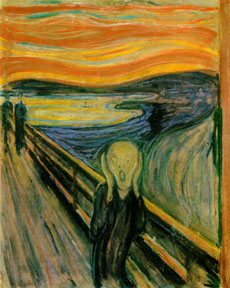
The Scream 1893
|

(African, 1800s)
|
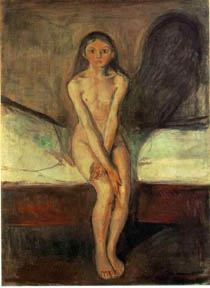
Puberty 1895
|
Munch (pronounced Muenk) was a Norwegian painter and printmaker
whose intensely psychological and emotional themes was a major influence on
the development of German Expressionism in the early 20th century. His painting The Scream is regarded as an icon of the existential anguish of the
post-industrial modern age. It may have been partly inspired by the raw quality
of African tribal art (the early 20th century was the first time the public
saw such works in art museums). Munch tended to focus on intense emotions,
such as those expressed in Puberty, which presents the fearful period
of a girl's life as she faces the uncomfortable transition of becoming a woman.
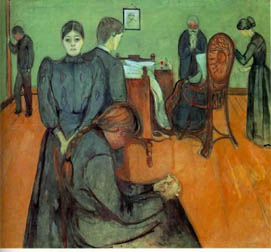
Death in the Sickroom 1895
|
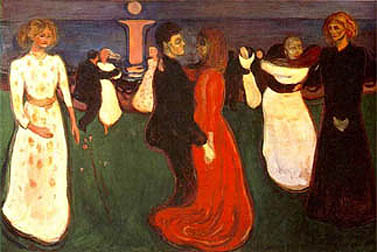
The Dance of Life 1900
|
The troubling nature
of many of Munch's works can be partly explained by events of his early
childhood, as well as the overly religious (and repressive) society in which
he lived. Raised in Norway (which is dark and cold throughout much of the
year), his mother died of tuberculosis when he was only five. Later, after
developing a close attachment to his sister, she suffered the same fate.
Art was, for Munch, a way to express his emotions of grief. Throughout his
life he was also known to be obsessed with women, though he was never to
marry. The Dance of Life focuses on the changing nature of woman
as she matures from innocence into full sexuality, and then to old age -
where she is again regarded as non-sexual.
Munch's clarity of expression
was to have a great influence on many artists who would come to be known
as "Expressionists". Though there were many developments in different
countries, the most famous and influential would be German Expressionism
and Fauvism (primarily a French movement).
There
were two groups of German Expressionist movements. One was called Die Brucke (meaning "the bridge"),
led by Kirchner. The other was called Der Blau
Rieter ("the Blue Rider"), led by Kandinsky.
Die Brucke ("The Bridge")
Ernst Ludwig
Kirchner
(1880 - 1938)
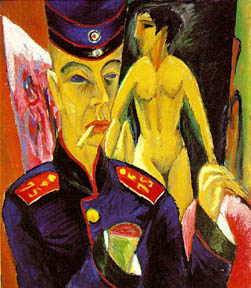
Self Portrait as a Soldier 1915
|
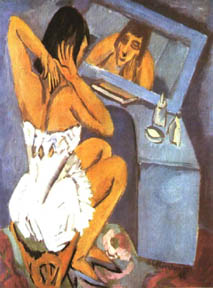
Woman and Mirror 1912
|
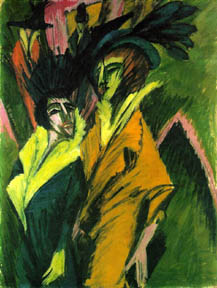
Two Women in the Street 1914
|
The beginning of Expressionism
took place in Germany, around the time of the first World War. In 1912,
Kirchner became the leader of a group of artists who called themselves "Die
Brucke". He and the other artists sought to build a " bridge"
between Germany's past and future. They felt that the art of the current
establishment was too academic and refined to retain any degree of expression,
so they instead found inspiration in medieval German art and primitive African
sculpture. Additionally, they would find inspiration in the emotionally
expressive works of Vincent Van Gogh and Edvard Munch. Since their primary
concern was the expression of deeply felt emotions, they would also transform
their negative feelings about the war onto canvas.
Kirchner achieved some
fame during his lifetime, and was fortunate to maintain a number of collectors
for his paintings. With the beginnings of WWII, however, his work was denounced
(as well as his compratriots) as "degenerate art", and confiscated
from museums. He became increasingly depressed by the war and took his own
life.
Emil Nolde
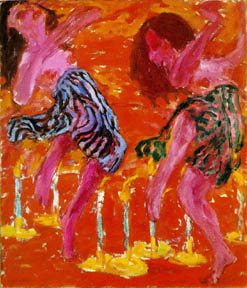
Candle Dancers 1912
|
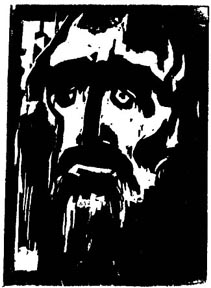
The Prophet, woodblock print
|
Der Blau Reiter ("The Blue Rider")
Wassily Kandinsky
(Russian, 1866-1944)
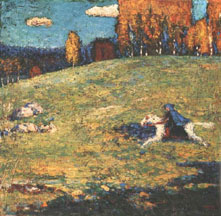
Blue Rider 1903
|
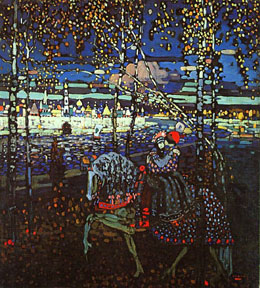
Riding Couple 1916
|
Though Kandinsky was born in Russia, he spent most of his creative years
in Germany, and would head up the second German Expressionist group, known
as "Der Blau Reiter". Kandinsky and his followers were more spiritually
inclined than the Die Brucke group (and had close ties with a new sect of
religious philosophy, known as theosophy). Kandinsky believed that colors,
shapes and forms had an equivalence with sounds and music, and sought to
create color harmonies which would be purifying to the soul. It is easy
to see the impressionistic influence in his very earliest works. As his
work progresses, it becomes increasingly abstract, until there is no longer
an image defined by the various shapes and colors. By this time, Kandinsky
had decided that the idea of creating paintings which were pictures of the
representational world was no longer necessary. He felt that society was
paving the way for a new, more spiritual age. Instead of focusing on the
material aspects of life, he felt his paintings could help prepare people
to see the spiritual, non-material world. Kandinsky is one of the first
(if not the first) artist to create completely non-representational paintings.
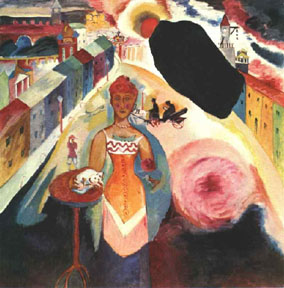
Woman in Moscow 1912
|
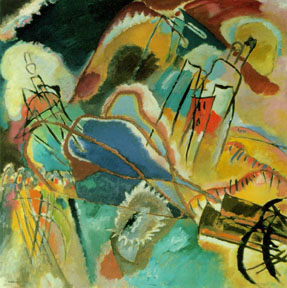
Improvisation 30, 1930
|
Franz Marc
(German,1880-1916)
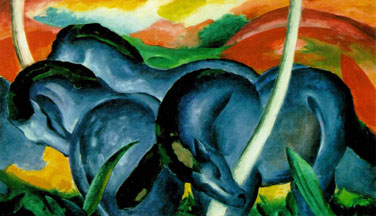
Blue Horses 1911
|
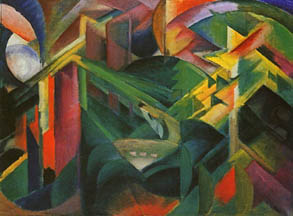
Deer in a Garden 1912
|
Franz Marc
is best known for his paintings of animals (particularly horses and deer)
in which he attempted to express his mystical veneration of nature. In works
such as Blue Horses, he used stylized lines and curves and brilliant
unrealistic color to create and heighten the sense of nature idealized. After
1913, in response to cubism and futurism, he turned to abstraction, creating
moods of clashing, discordant uncertainty. He was killed in action during
World War I.
Austrian Expression
Gustav Klimt
Gustav Klimt was the leader
of a group called the Viennese Seccession, which sought to separate itself
from the naturalist movement which was popular in early 20th century Austria.
His work is difficult to categorize, but is often associated with the Symbolists
and Art Nouveau, but it also has some ties to Expressionism. Though he was
supported by many members of the Viennese aristocracy (and painted many of
thier portraits), his work was also widely criticized for its eroticism.
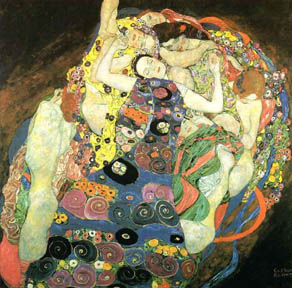
Maiden (the Virgin) 1914
|
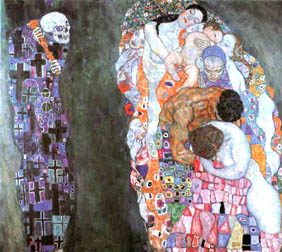
Death and Life 1916
|
French Fauvism
Fauvism
(pronounced Foev-ism) was the most optomistic movement linked to expressionism.
This can be explained by its birthplace, in Paris. When viewing these works,
it is easy to imagine the bohemian lifestyle of the artists. Parisians enjoyed
getting together in the cafes, listening to music and drinking wine. They
also enjoyed outdoor activities in the sun. Their art expresses more of pleasure
than it does of the complex (often negative) emotions expressed in the north.
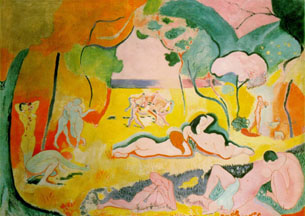
Henri Matisse, Joy of Life 1905
|
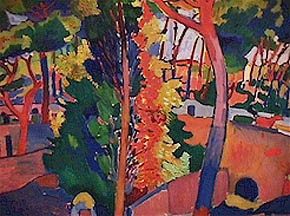
Andre Derain, Landscape 1905
|
Fauvism was a brief but
important art movement that followed the Post-Impressionism movement in France.
Matisse is regarded as the leader of the movement, but Andre Derain was also
significant (Braque also briefly painted in the style, before his cubist experiments).
Each part of their paintings had loud colors, primitive elements, and wild
ideas. Although the movement only lasted four years, it would have a profound
effect on future artists, especially in terms of their use of color. Though
initially inspired by Impressionism and Post Impressionist works, the colors
used were even more saturated and high keyed. The effect was very bold, almost
loud. Fauvism is recognized for its influence on cubism and modern expressionism
in its flattened space, disregard for natural forms and its love of unbridled
color.
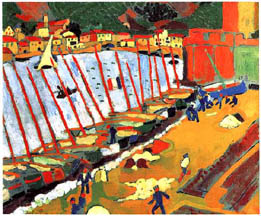
Andre Derain, Suburb of Collioure 1905
|
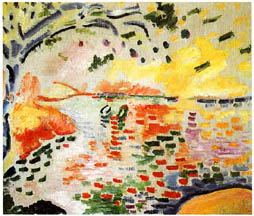
George Braque, Bay of La Ciot 1907
|
Henri
Matisse
(After his Fauvist Period)
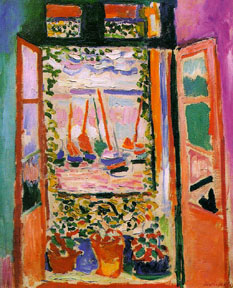
The Window 1905
|
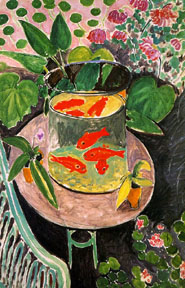
Goldfish 1911
|
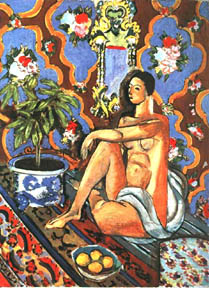
Decorative Figure 1925
|
After 1905, Matisse continued to use bright colors and bold
compositions, yet these works are no longer considered to be of the Fauvist
period. The most evident change in his work is his increased interest in patterns
and the continued flattening of pictorial space. Matisse is, along with Picasso,
regarded as one of the most influential artists of the 20th century. His work
is more decorative than Picasso's, but also less troubling. A famous quote
by Matisse is that he felt that art should be like a good armchair to come
home to after a hard day's work. Though he lived through two world wars, he
decided not to focus on what was wrong with the world. Instead, he felt that
art should provide a place for the soul to rest.
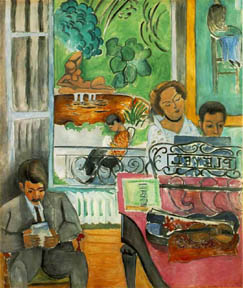
The Music Lesson 1917
|

La Musique 1939
|
Matisses's
latest artworks, are often regarded as his most innovative. They were created
after a he was handicapped from severe arthritis which limited him to a wheelchair.
Unable to stand to paint, he began cutting out shapes from colored pieces
of paper. These he had glued (with help from assistants) to huge pieces of
paper. The effect is extremely bold and light-hearted. The colors and shapes
have a liberating sense about them. One feels that, despite his problems,
Matisse has succeded in returning to a carefree childhood.
|